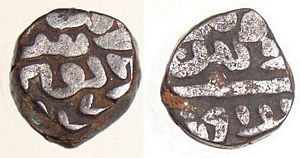Ibrahim Khan Lodi facts for kids
Quick facts for kids Ibrahim Khan Lodi |
|
|---|---|
| Sultan of the Lodi Dynasty | |
 |
|
| 31st Sultan of Delhi | |
| Reign | 1517 – 21 April 1526 |
| Coronation | 1517, Agra |
| Predecessor | Sikandar Khan Lodi |
| Successor | Sultanate abolished By (Babur as Mughal Emperor) |
| Born | 1480 Delhi |
| Died | 21 April 1526 (aged 45–46) Panipat |
| Burial | Tomb of Ibrahim Lodi |
| Issue | Jalal Khan Lodi A daughter (married Nusrat Shah of Bengal) |
| House | Lodi dynasty |
| Father | Sikandar Khan Lodi |
| Religion | Sunni Islam |
Ibrahim Khan Lodi (born 1480 – died April 21, 1526) was the very last Sultan of the Delhi Sultanate. He became Sultan in 1517 after his father, Sikandar Khan Lodi, passed away. Ibrahim Lodi was the final ruler of the Lodi dynasty. He ruled for nine years until 1526. That year, he was defeated and killed in the famous Battle of Panipat. This battle was against Babur's invading army. After Ibrahim Lodi's defeat, the Mughal Empire began in India.
Contents
Ibrahim Lodi's Story
Ibrahim Lodi was from the Pashtun ethnic group. He became king after his father died. However, he wasn't as good at ruling as his father had been. He faced many challenges and rebellions during his time as Sultan.
Ibrahim Khan Lodi also upset the important noblemen and leaders in his court. He replaced older, experienced commanders with younger ones who were more loyal to him. Eventually, some of his own Afghan noblemen invited Babur to invade India.
The Battle of Panipat
In 1526, the Mughal forces led by Babur attacked. Babur was the king of Kabulistan, which is now Kabul in Afghanistan. His army defeated Ibrahim's much larger army in the First Battle of Panipat. Ibrahim Lodi was killed during this battle.
Historians believe Babur's army had about 12,000 to 25,000 soldiers. They also had between 20 and 24 cannons. Ibrahim Khan Lodi's army was much bigger, with around 50,000 to 120,000 men. He also had about 400 to 1,000 war elephants.
Even with more soldiers and elephants, the Lodi forces lost badly. Over 20,000 of their soldiers were killed. Many more were wounded or captured. After the Lodi dynasty ended, the Mughal Empire began its rule. This new empire lasted for the next 331 years.
Where is Ibrahim Lodi Buried?
Many people mistakenly think Ibrahim Lodi's tomb is the Shisha Gumbad in Lodi Gardens in Delhi. But his real tomb, called the Ibrahim Khan Lodi's Tomb, is actually in Panipat. It's located near the local government office (called a tehsil office). It's also close to the shrine (called a Dargah) of the Sufi saint Bu Ali Shah Qalandar.
The tomb is a simple rectangular building. It sits on a high platform with steps leading up to it. In 1866, the British moved the tomb. This happened when they were building the Grand Trunk Road. They also fixed it up and added a special message. This message highlights Ibrahim Khan Lodi's death in the Battle of Panipat. Ibrahim Lodi also built another tomb, the Khwaja Khizr Tomb, in Sonipat in 1522.
Family Trouble: Jalal Khan's Rebellion
In 1520, Ibrahim's older brother, Jalal Khan Lodi, caused trouble. Jalal Khan was supposed to be the next in line for the throne. He marched with an army from Jaunpur towards Delhi. He wanted to take the throne for himself.
When Ibrahim Lodi heard about Jalal Khan's rebellion, he acted quickly. He put his other brothers, Ismail, Husein, Daulat, and Mahmud, in prison at the fort of Hansi. Then, he marched towards Awadh to meet his brother Jalal's army. After defeating Jalal's army, Ibrahim surprisingly forgave his brother. He then made him governor of Jaunpur and Lakhnau (which is now Lucknow).
Pictures of Ibrahim Lodi's Time
-
A coin from the Malwa Sultanate (1520-1 CE). It shows the name of Ibrahim Lodi, Sultan of Delhi.
See also
 In Spanish: Ibrahim Lodi para niños
In Spanish: Ibrahim Lodi para niños
- Sher Shah Suri
- Tomb of Ibrahim Lodi





